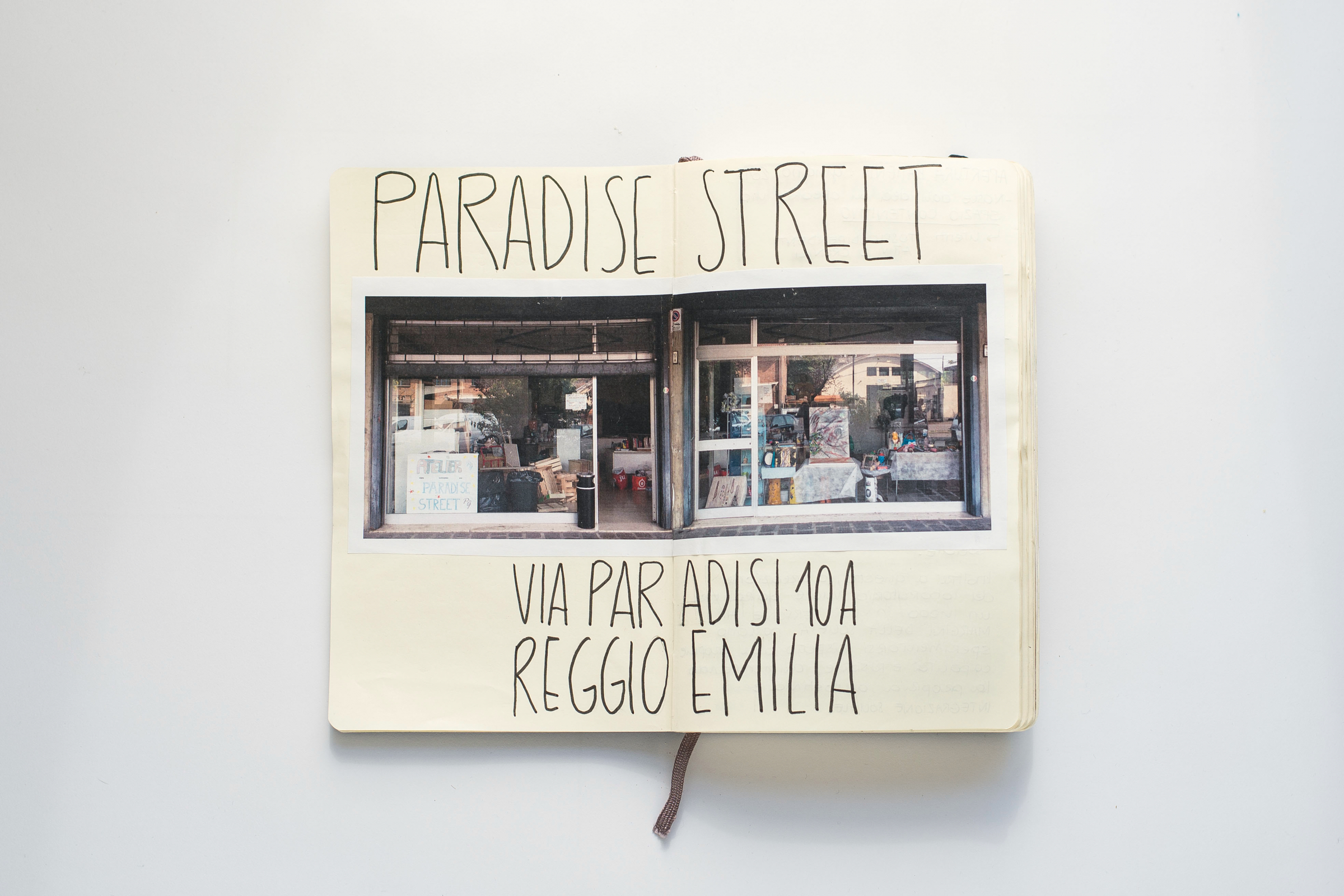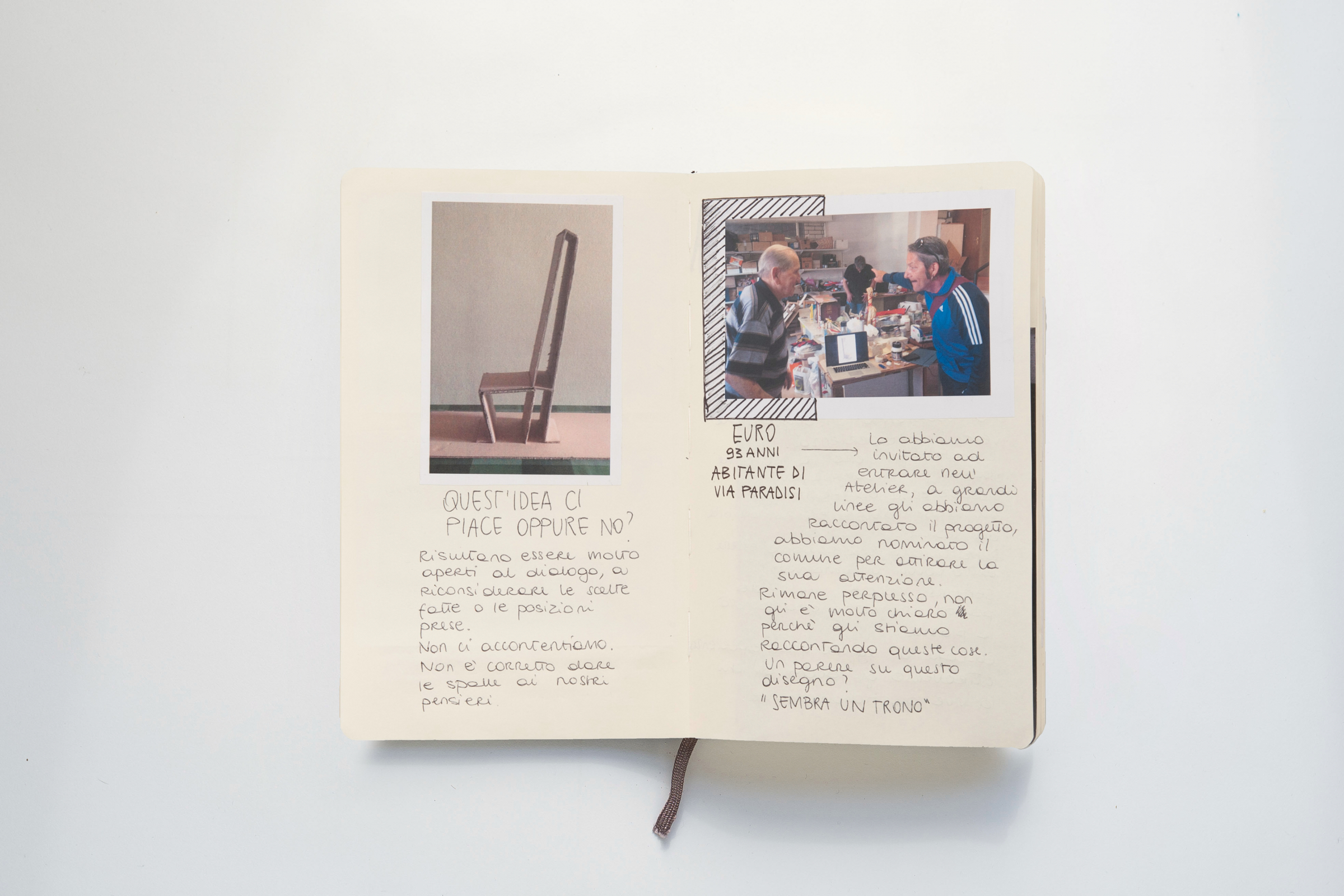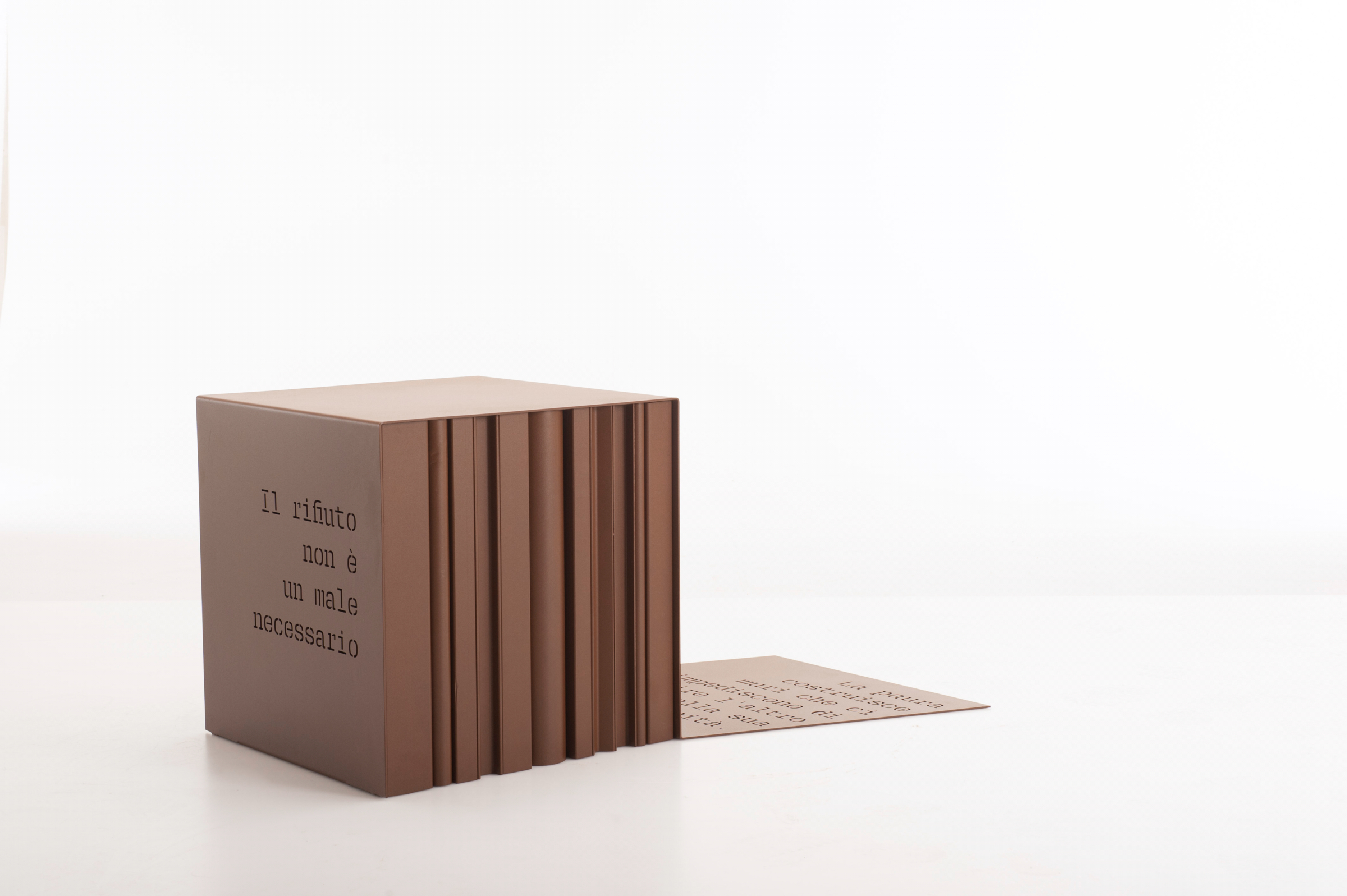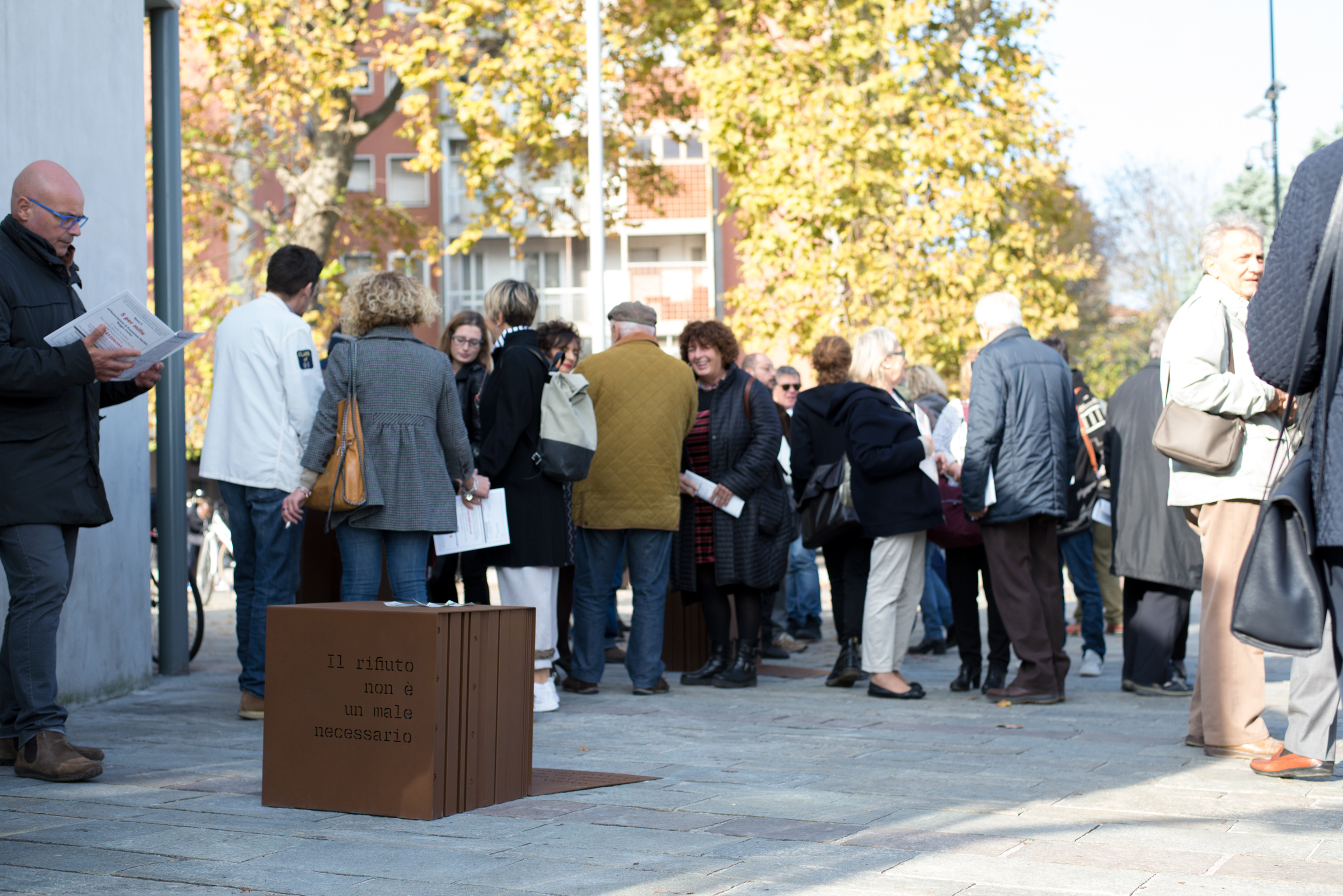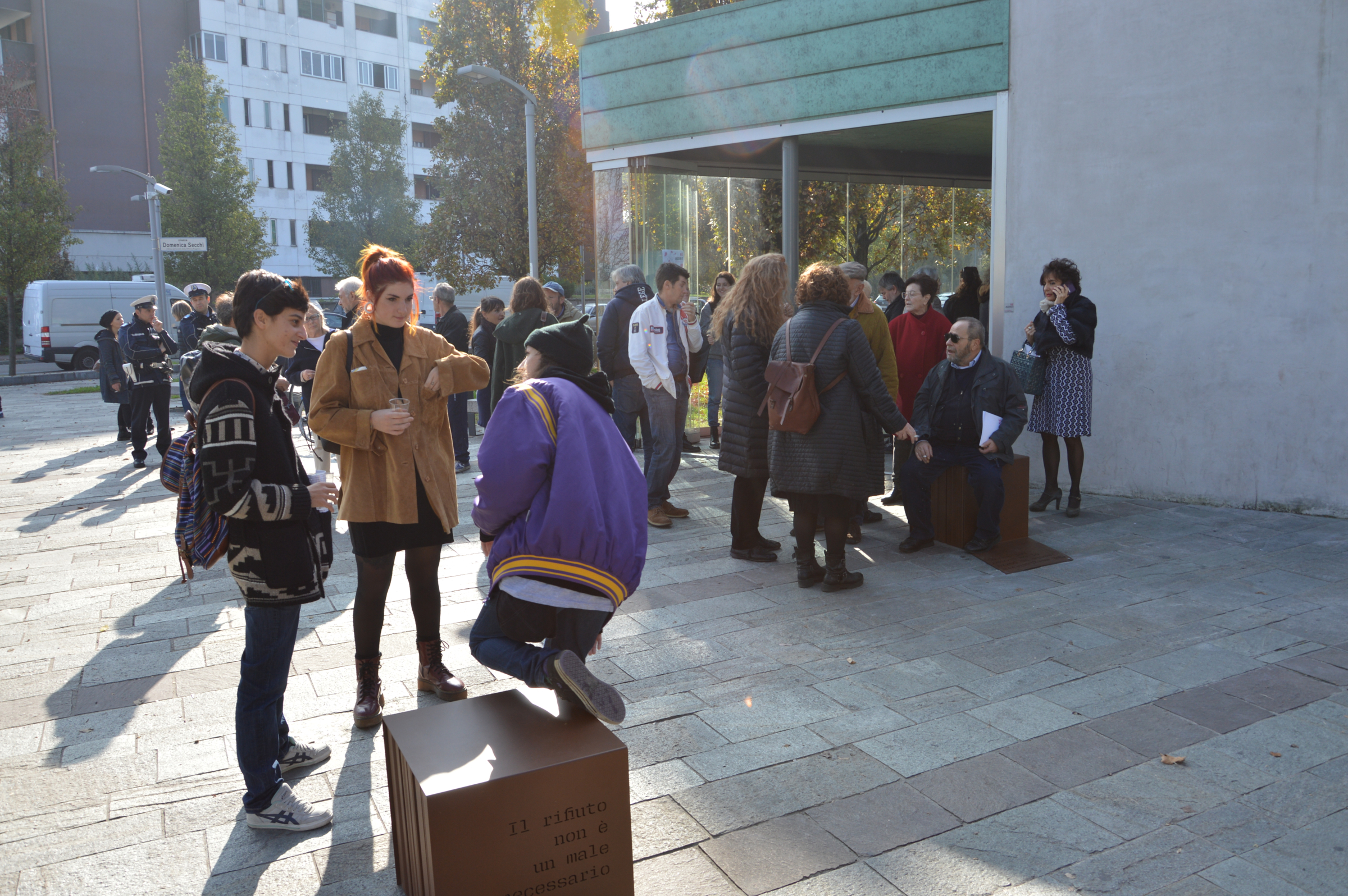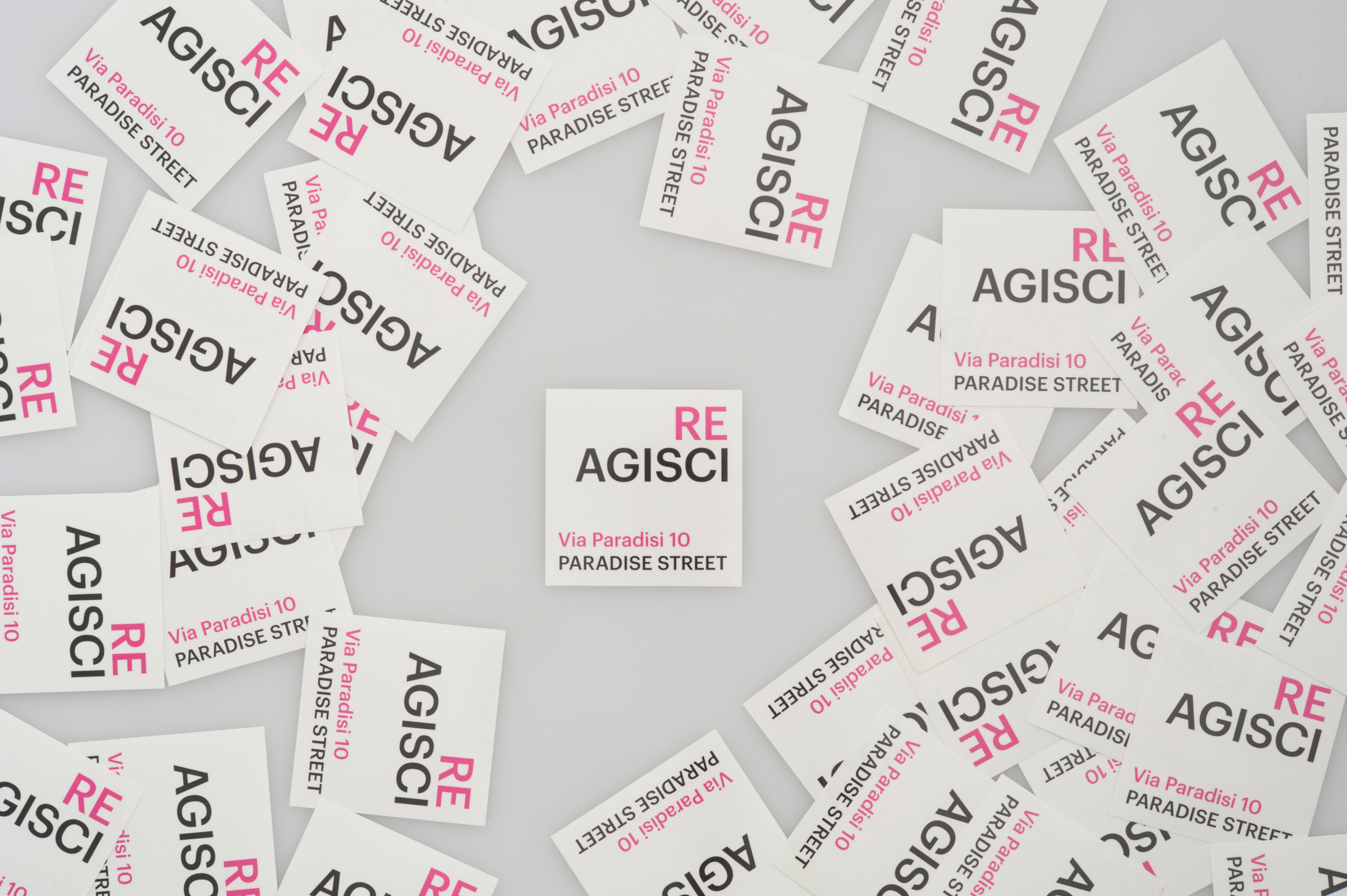REagire
design sociale, riqualificazione,
arredo urbano
3 sedute,
1 leggio,
1 diario
Settembre 2016, Piazza Domenica Secchi, Reggio Emilia
Esposizioni:
• REagire è rimasta installata in Piazza Domenica Secchi dal 2016 sino al Febbraio 2020, quando è stata rimossa per volontà del Comune di Reggio Emilia.
Pubblicazioni:
• REagire su Sardarch
Come disse Bruce Mau: “… per favore fate sentire la vostra voce nel coro del potenziale. Addentratevi nella discussione e abbandonate le vostre paure riguardo all’ostacolo che vi separa dal resto del mondo dietro di voi. Ferma il lamento e unisciti alla rivoluzione del possibile”.
Da queste riflessioni nasce il desiderio di cercare di sperimentare se sia davvero possibile fare del design sociale, coinvolgendo le comunità, lavorando con soggetti svantaggiati, inserendosi in una realtà, in un contesto per avvicinarsi a quei problemi che, oggi più di ieri, assillano la nostra società.
“Ciò che mi interessa sono le persone, gli uomini. In loro vorrei far scaturire qualcosa.”
Ettore Sottsass
REagire è un progetto per restituire protagonismo a persone e luoghi marginalizzati. Nato dall’idea di voler sperimentare nuove vie per costruire inclusione sociale tramite il design, cerca di ripensare e riprogettare le interazioni sociali. REagire è il risultato di un percorso di co-progettazione attivato con l’Assessorato alla Sicurezza del Comune di Reggio Emilia e l’Atelier Paradise Street di via Paradisi, un laboratorio in cui le persone seguite dal Servizio dipendenze patologiche della città (SerT) vengono coinvolte in attività creative e formative.
Per alcuni mesi abbiamo affiancato gli educatori, con lo scopo di pensare un progetto che potesse coinvolgere le persone frequentanti l’atelier, rendendole parte attiva e protagoniste della progettazione. Questo per cercare di riattivare le capacità creative degli utenti del laboratorio, al fine di far nascere in loro una nuova consapevolezza di sé e del loro potenziale, attraverso un lavoro di progettazione strutturato. Il percorso di co-progettazione si è articolato in diverse fasi: dalla definizione del concept alla scelta della direzione ideale da intraprendere; dall’analisi dello spazio allo studio delle forme; dal recupero dei materiali alla stesura dei pensieri.
Il risultato di questa collaborazione è infatti un intervento urbano; un’installazione che parla di rifiuto, capace di incarnare e di trasmettere alla cittadinanza una tematica delicata come quella della marginalizzazione sociale. L’intervento urbano consiste nell’installazione di tre sedute e un leggio.
Le sedute, in linea con quelle già presenti nella piazza, sono state pensate e posizionate lontane una dall’altra per far provare al fruitore l’esperienza della solitudine nata dall’emarginazione. L’esperienza della sosta solitaria è accompagnata da frasi leggibili sul prolungamento a terra della seduta.
“La paura costruisce muri che ci impediscono di scoprire l’altro nella sua umanità.”
“Chi marginalizza lascia un pezzo di se stesso nel vuoto.”
“Se comprendere è difficile, conoscere è necessario.”
Queste le tre frasi pensate dagli utenti dell’atelier per accompagnare e fornire una chiave di lettura dell’installazione ai passanti.
Significativo è anche lo slogan scelto e inciso dietro ogni seduta: “Il rifiuto non è un male necessario”, certamente un omaggio al Professor La Cecla. L’installazione si completa con il leggio, che contiene la spiegazione del progetto.
I manufatti pensati e progettati insieme sono stati realizzati grazie alla collaborazione di aziende del territorio che hanno creduto nel progetto e messo a disposizione materiali di scarto e manodopera: Ugolotti Eolo snc, Donelli Dimaf, Gpm Project srl, Carpenteria Barbieri snc, Frontera Alfonso Il Fabbro e Red Fox.
L’installazione è stata inaugurata il 29 Ottobre 2016 in piazza Domenica Secchi a Reggio Emilia alla presenza dell’Assessora alla Sicurezza del Comune di Reggio Emilia, Natalia Maramotti.
As Bruce Mau said: “… please make your voice heard in the chorus of potential. Enter the discussion and abandon your fears about the obstacle that separates you from the rest of the world behind you. Stop whining and join the revolution of the possible “.
Inspired by these words, we wanted to explore the potentials of social design to understand what can be achieved in our local context by involving communities and disadvantaged subjects, thus concretely addressing a problem that, today more than ever, plagues our society.
“What interests me is people, humans. It’s in them I want to foster the emergence of something new.”
Ettore Sottsass
REagire is a project to requalify and re-empower marginalized people and areas of the city. Born from the desire to experiment with new ways of building social inclusion by design, it aims to fundamentally rethink and redesign social interactions. REagire is the result of a co-planning itinerary activated with the Department of Security of the Municipality of Reggio Emilia and the Paradise Street Atelier in via Paradisi, a social lab where the people followed by the city’s addiction disorder authorities (SerT) are involved in creative and training activities.
For a few months we have been cooperating with the lab educators to conceive a project that could actively involve the people attending the atelier, by making them directly responsible of the design process. This was intended to reactivate the creative skills of the lab participants and give them a new awareness of themselves and their potential in the context of structured design planning. The co-design process has been divided into different phases: from the definition of the concept to the choice of the general creative direction; from the analysis of space to the study of forms; from the recovery of materials to the drafting of thoughts and ideas.
The result of this collaboration is in fact an urban intervention; an installation that speaks of rejection, capable of embodying and transmitting to the entire citizenship a delicate theme such as that of social exclusion and marginalization. The urban installation consists of three seating blocks and a bookstand.
The blocks, in line with those already present in the square, have been designed and positioned far from each other in order to make the people who sit down feel the loneliness born of marginalization. The experience of exclusion is strengthened by 3 quotes written on the base of the blocks.
“Fear builds walls that prevent us from discovering the other in his humanity.”
“He who marginalizes others leaves a piece of himself in the void.”
“If understanding is difficult, knowing is necessary.”
These are the three phrases chosen by the users of the atelier to accompany the installation and provide an explanatory key for the passers-by. The quote chosen and engraved behind every sitting block is also significant: “Rejection is not a necessary evil”, which is a tribute to Professor La Cecla. The installation is completed by the bookstand, which contains the full explanation of the project.
All the elements of the installation have been conceived and designed together, and were realized thanks to the collaboration of local companies that believed in the project and contributed with waste materials and skilled labor: Ugolotti Eolo snc, Donelli Dimaf, Gpm Project srl, Carpenteria Barbieri snc, Frontera Alfonso Il Fabbro and Red Fox.
The installation was inaugurated on October 29, 2016 in piazza Domenica Secchi in the presence of the Councilor of Security of the Municipality of Reggio Emilia, Natalia Maramotti.
Credits
“REagire” è un progetto di Materia Critica.
Suggestioni sul tema:
• V. AURICCHIO, Social Design,
in “Ottagono”, n. 268, marzo 2014
• A. THORPE, Architecture & Design versus Consumerism: how design activism confronts growth, Routledge, 2012
• M. DOWNIE, S.ESHKAR & P. KAISER, Creative Collaboration, Sitra, 2012
• F. LA CECLA, Contro l’urbanistica,
Giulio Einaudi Editore, 2015
• B. MUNARI, Da cosa nasce cosa. Appunti per una metodologia progettuale, Ed Laterza
• L. URBANUCCI, Design from all. Coniugare design e inclusione sociale, Csv Chieti, 2014
• E. MANZINI, Design, When Everybody Designs, MIT Press, 2015
• R. SOMMER, Social design: Creating buildings with people in mind, 1983
• IDEO, Design for social impact, The Rockefeller Foundation
• G. SCABIA, Marco Cavallo. Da un ospedale psichiatrico la vera storia che ha cambiato il modo di essere del teatro e della cura, Edizioni Alpha Beta Verlag, Merano 2011

